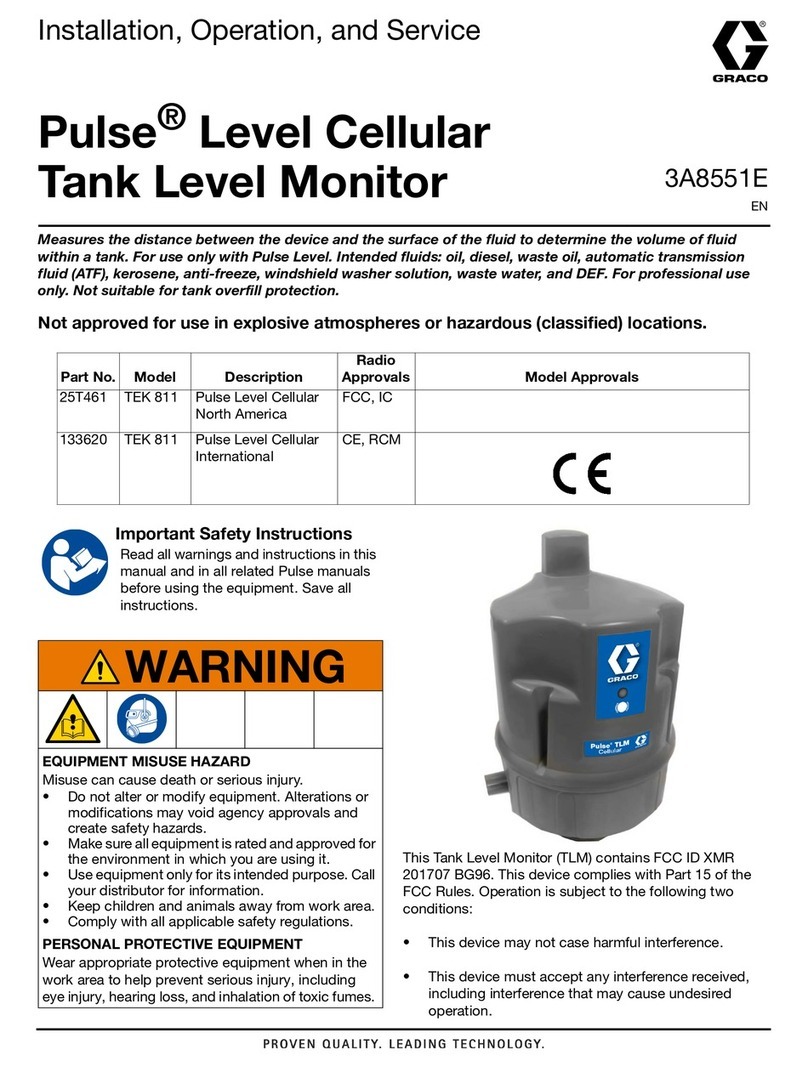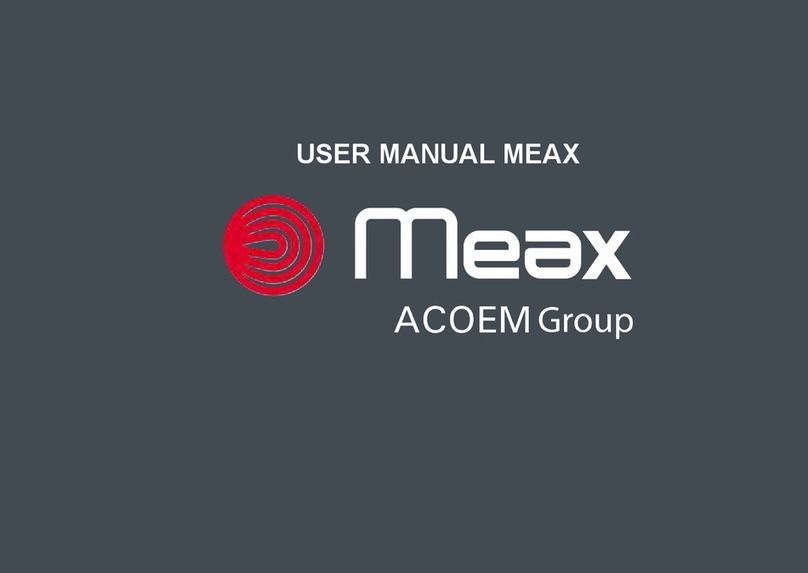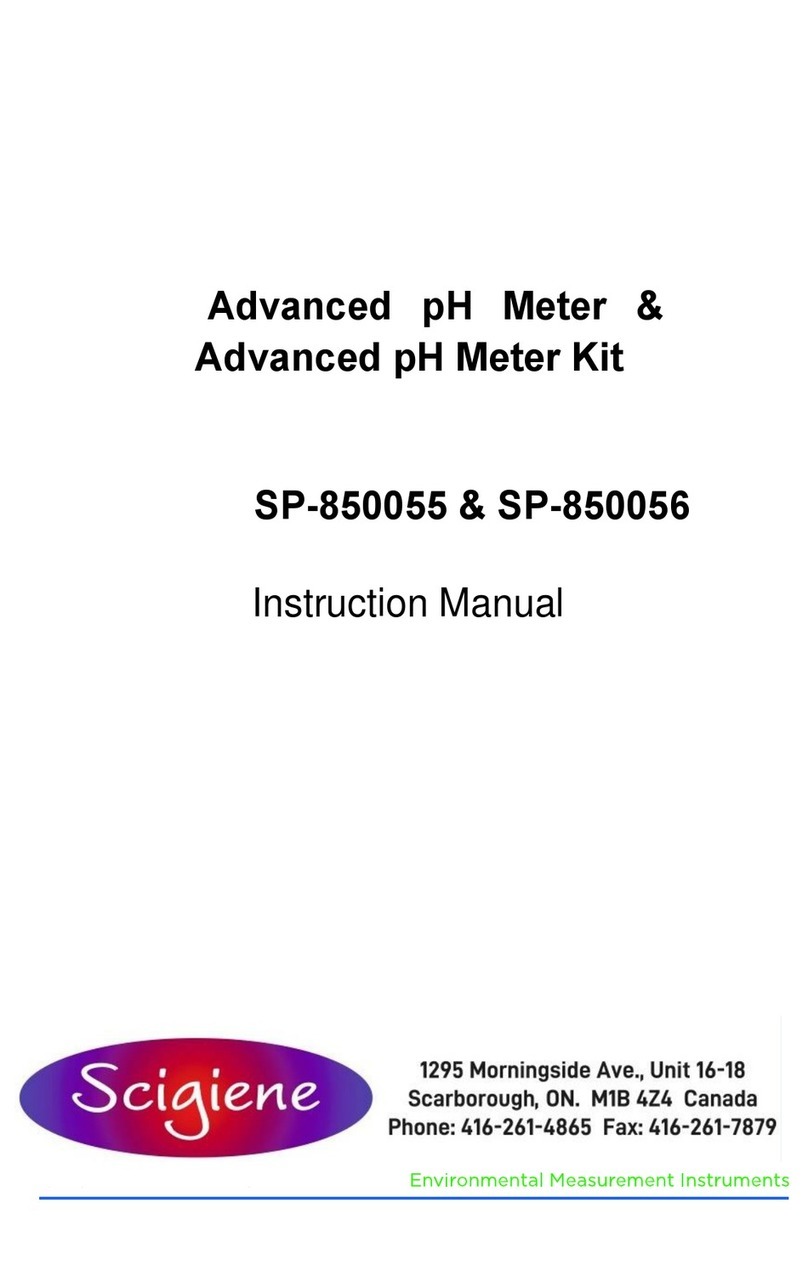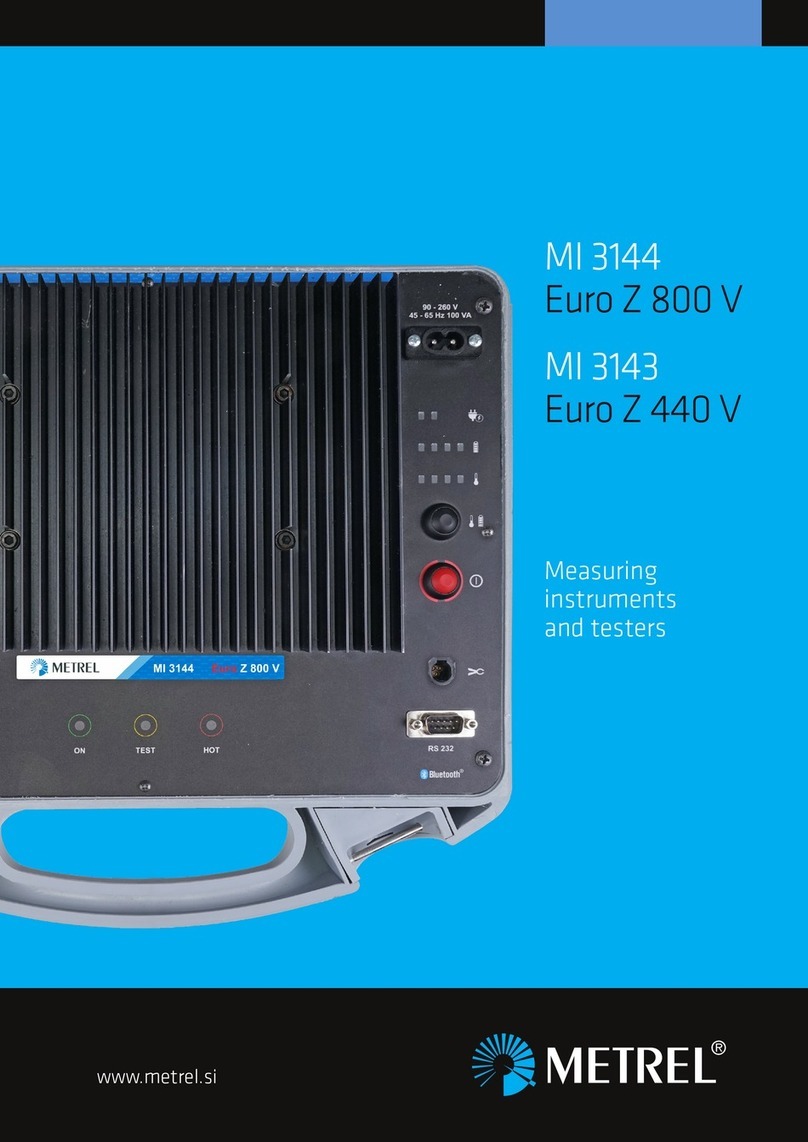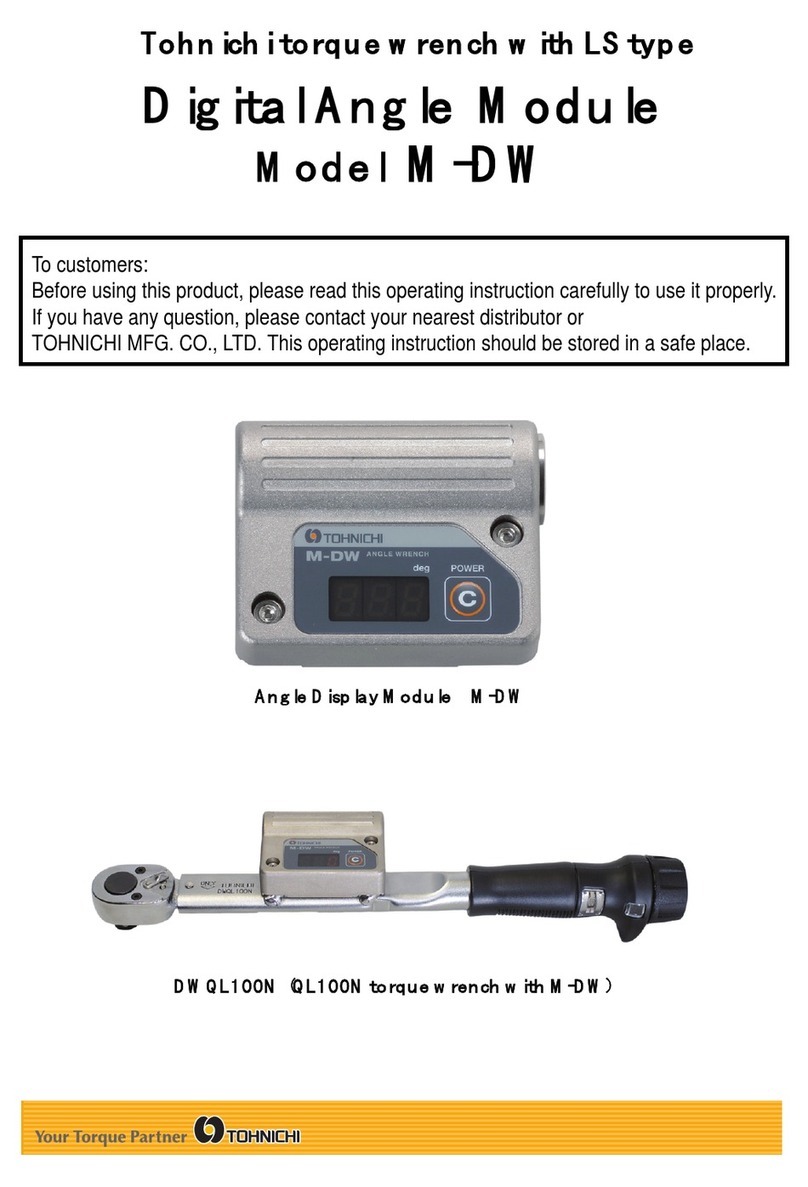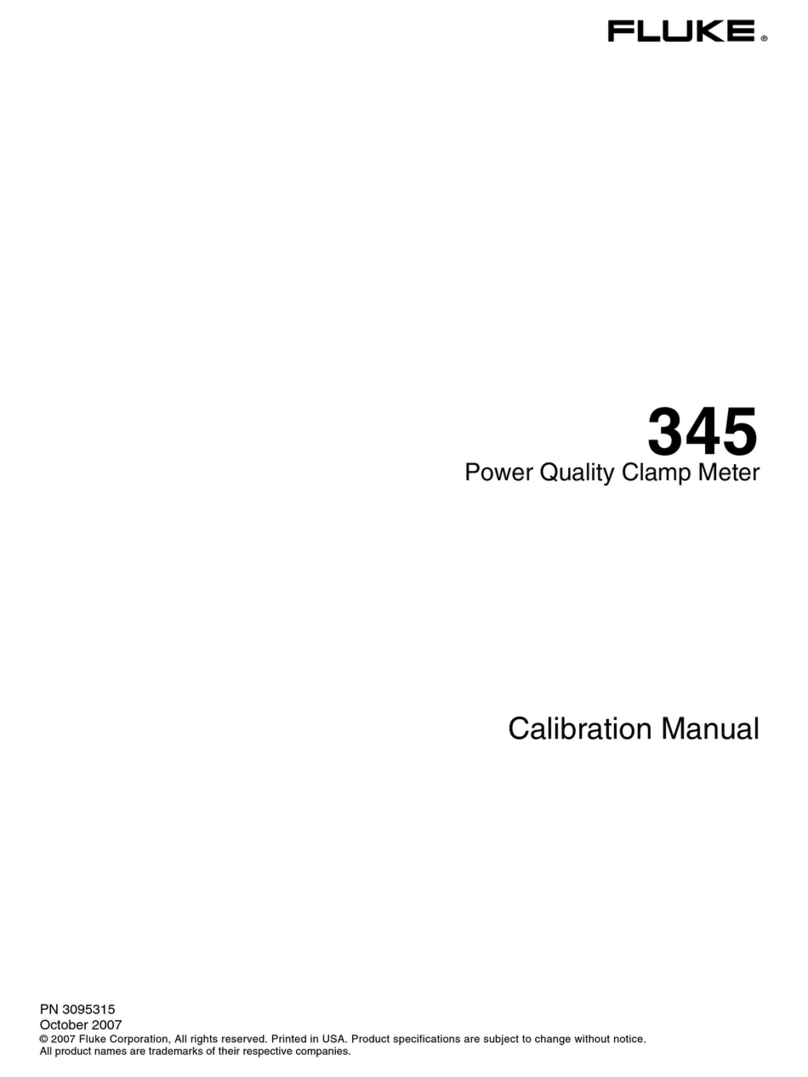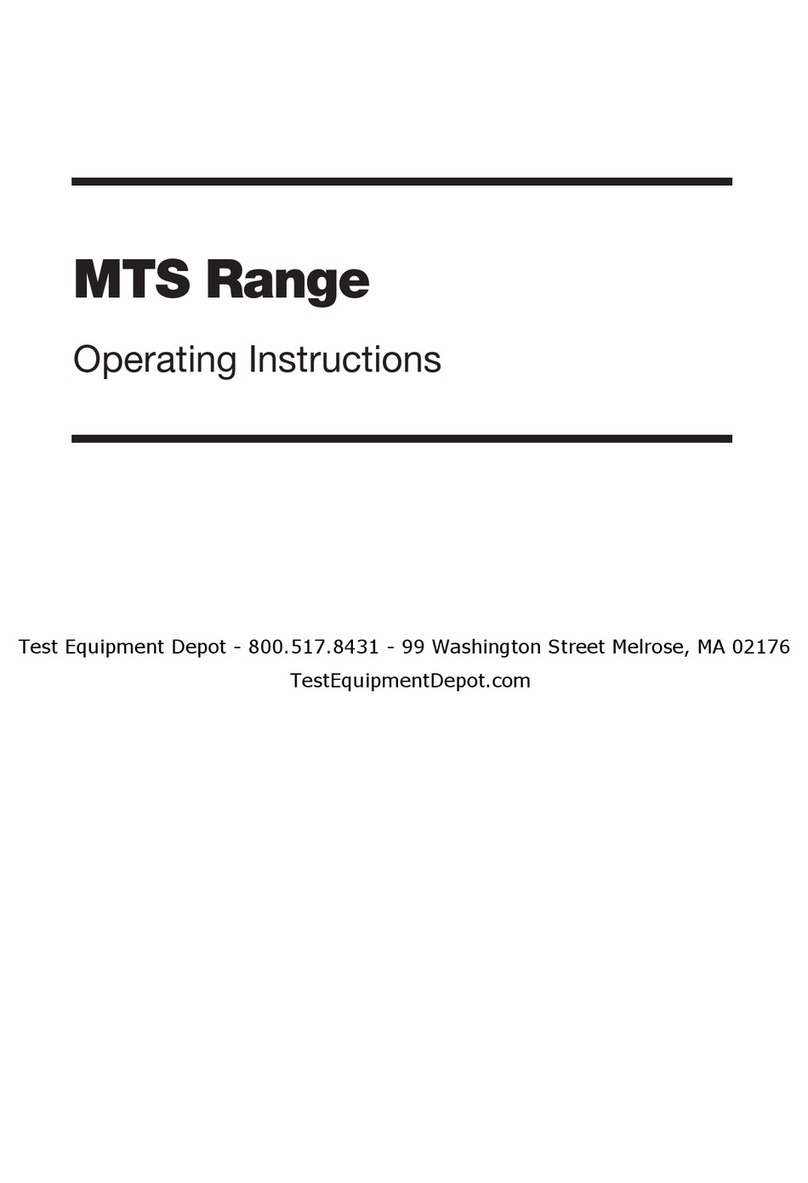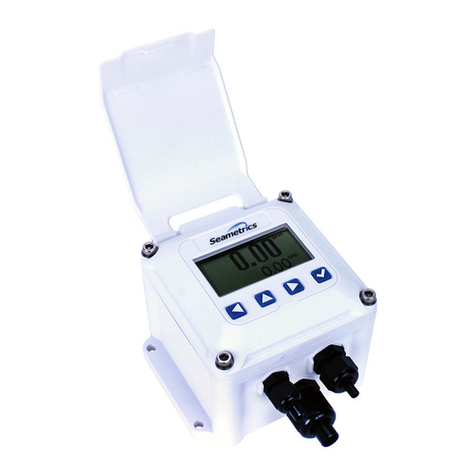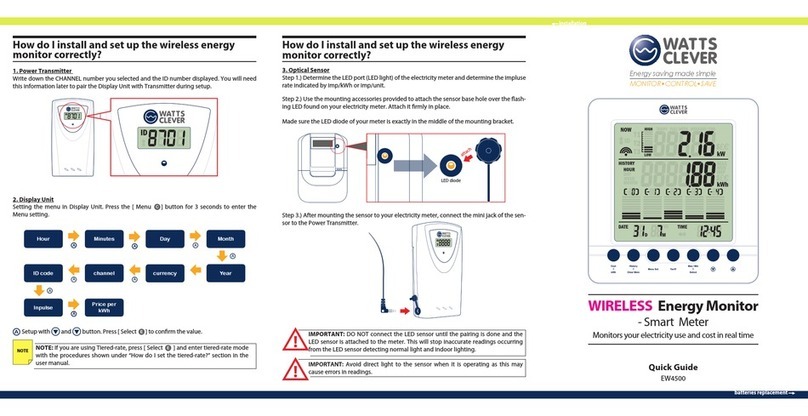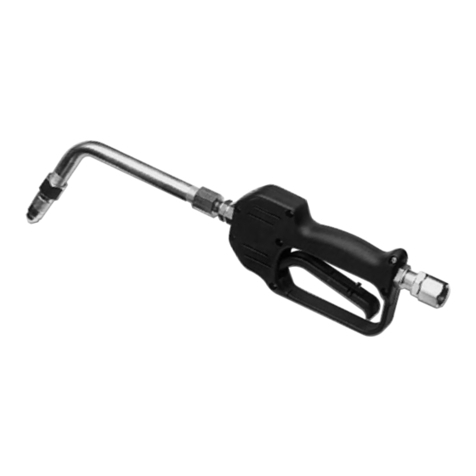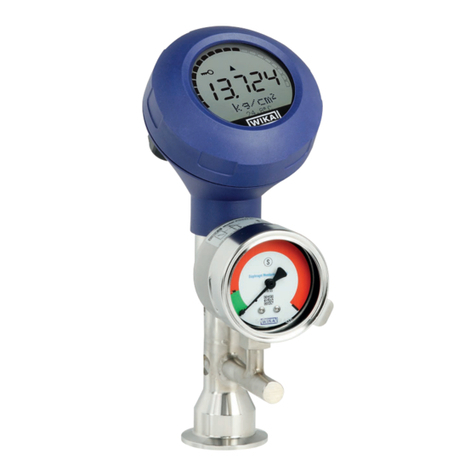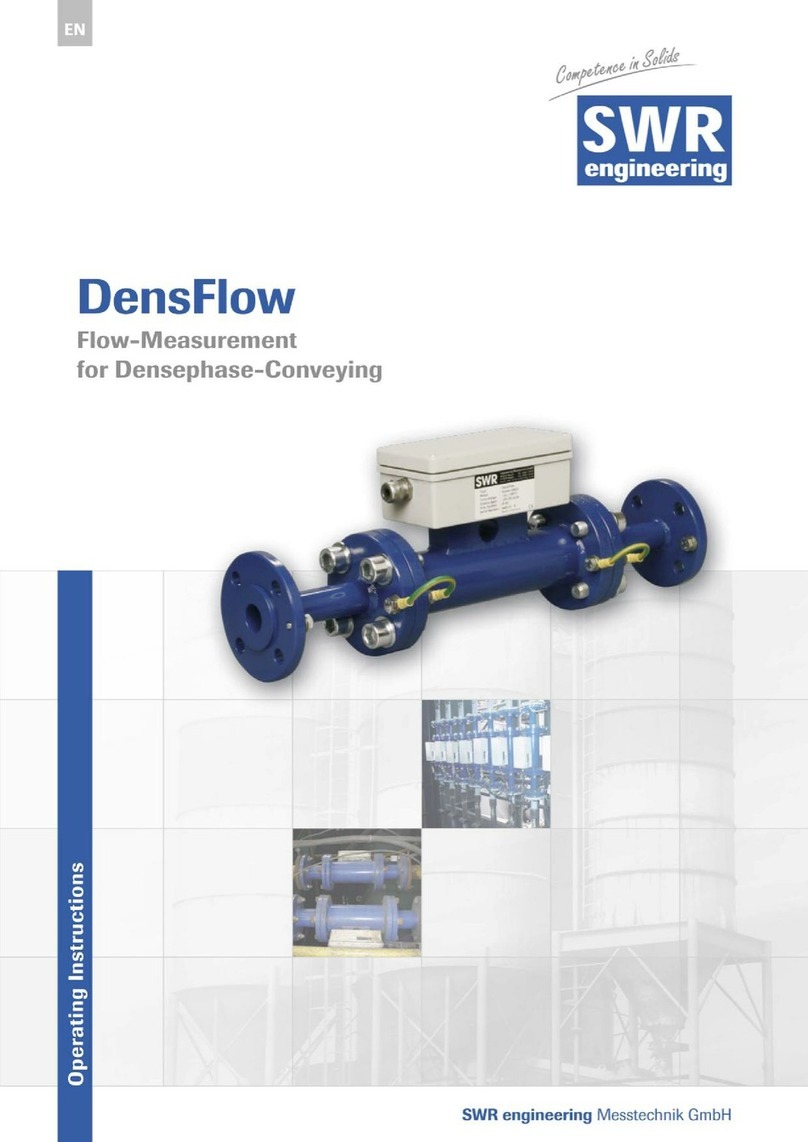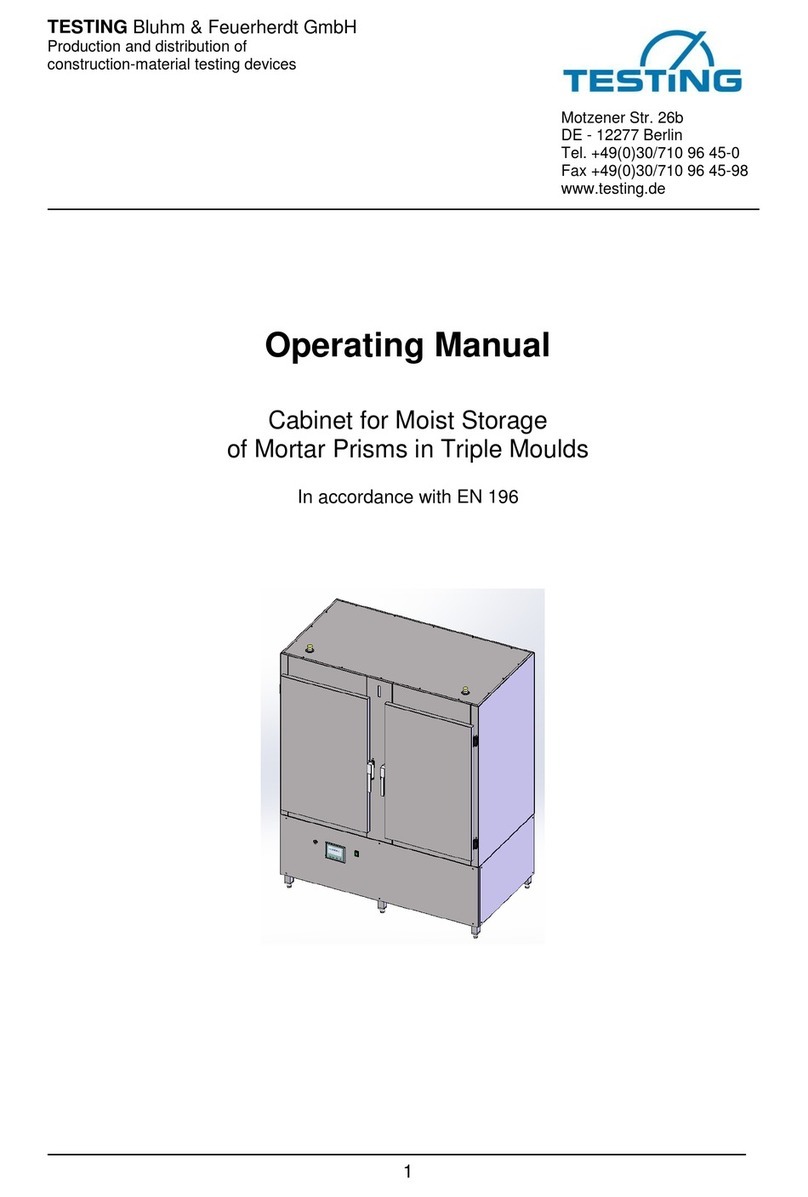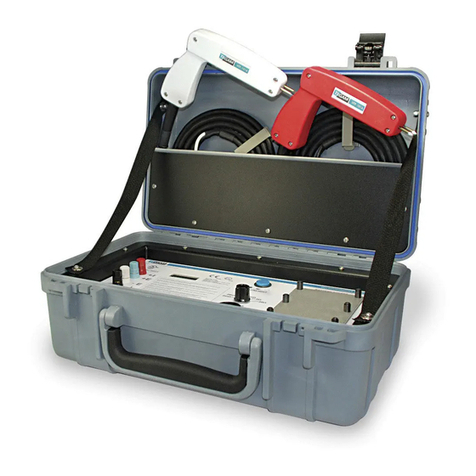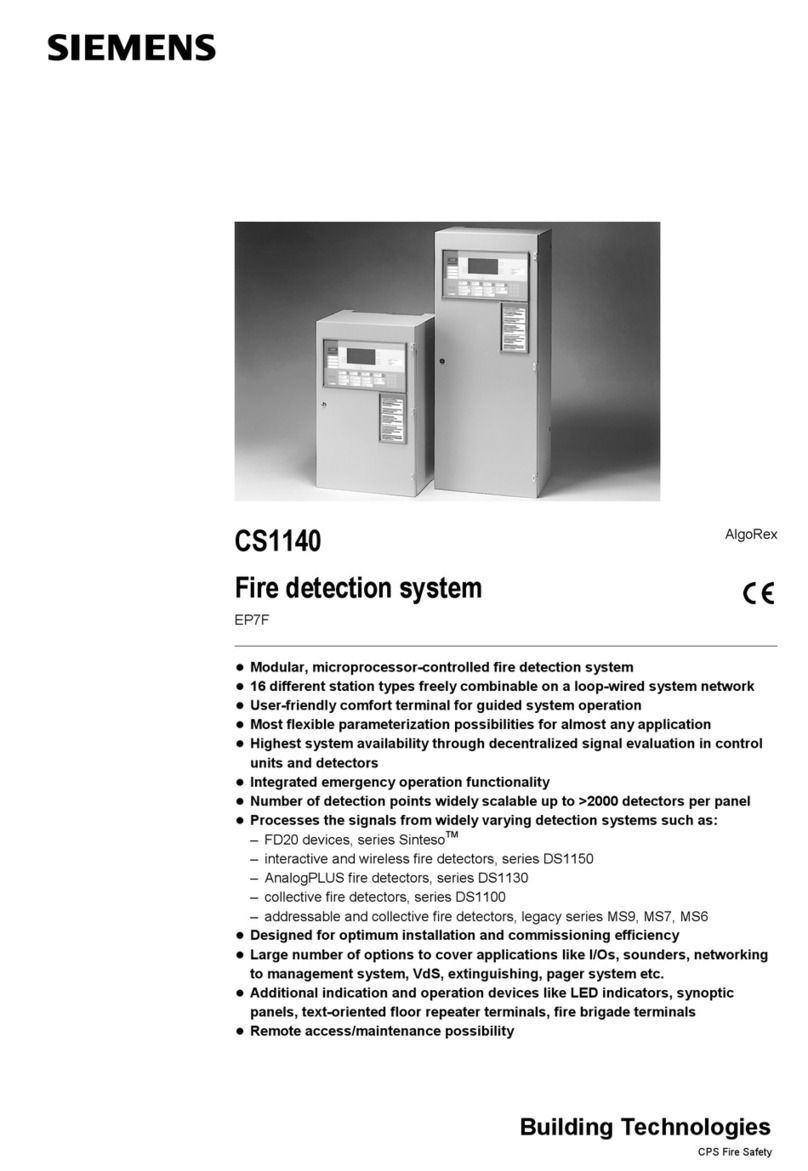SPEX NanoSNAP User manual

Operating Manual
Spex NanoSNAP™
Nano Spectrophotometer for Nucleic Acids
and Proteins Measurement

Operating Manual
2
1300-87076-1A Rev. 1
Contents
1.0 Safety Precautions . . . . . . . . . . . . . . . . . . . . . . . . . . . . . . . . . . . . . . . 4
1.1 Intended Use . . . . . . . . . . . . . . . . . . . . . . . . . . . . . . . . . . . . . . . . . . . 4
1.2 General Instrument Safety. . . . . . . . . . . . . . . . . . . . . . . . . . . . . . . . . . . . 4
1.3 Chemical Waste Safety . . . . . . . . . . . . . . . . . . . . . . . . . . . . . . . . . . . . . 6
2.0 General Description . . . . . . . . . . . . . . . . . . . . . . . . . . . . . . . . . . . . . . 7
2.1 Features . . . . . . . . . . . . . . . . . . . . . . . . . . . . . . . . . . . . . . . . . . . . . . 7
2.2 Product Overview . . . . . . . . . . . . . . . . . . . . . . . . . . . . . . . . . . . . . . . . 7
3.0 Getting Started . . . . . . . . . . . . . . . . . . . . . . . . . . . . . . . . . . . . . . . . . 9
3.1 Unpacking. . . . . . . . . . . . . . . . . . . . . . . . . . . . . . . . . . . . . . . . . . . . . 9
3.2 Initial Operation. . . . . . . . . . . . . . . . . . . . . . . . . . . . . . . . . . . . . . . . . .10
3.3 Main Screen. . . . . . . . . . . . . . . . . . . . . . . . . . . . . . . . . . . . . . . . . . . .10
3.4 Detection Arm Opening/Closing . . . . . . . . . . . . . . . . . . . . . . . . . . . . . . . . 11
3.5 Adjusting the Pathlength Selector . . . . . . . . . . . . . . . . . . . . . . . . . . . . . . . 12
3.6 Basic Operation. . . . . . . . . . . . . . . . . . . . . . . . . . . . . . . . . . . . . . . . . .12
4.0 Application: Nucleic Acid. . . . . . . . . . . . . . . . . . . . . . . . . . . . . . . . . . . .14
4.1 Overview of Screen Features . . . . . . . . . . . . . . . . . . . . . . . . . . . . . . . . . . 14
4.2 Protocol Operation . . . . . . . . . . . . . . . . . . . . . . . . . . . . . . . . . . . . . . . .15
4.3 Calculation . . . . . . . . . . . . . . . . . . . . . . . . . . . . . . . . . . . . . . . . . . . . 16
5.0 Application: Protein A280 . . . . . . . . . . . . . . . . . . . . . . . . . . . . . . . . . . . 17
5.1 Overview of Screen Features . . . . . . . . . . . . . . . . . . . . . . . . . . . . . . . . . . 17
5.2 Protocol Operation . . . . . . . . . . . . . . . . . . . . . . . . . . . . . . . . . . . . . . . .18
5.3 Calculation . . . . . . . . . . . . . . . . . . . . . . . . . . . . . . . . . . . . . . . . . . . . 19
6.0 Application: Protein Assay . . . . . . . . . . . . . . . . . . . . . . . . . . . . . . . . . . 20
6.1 Overview of Screen Features . . . . . . . . . . . . . . . . . . . . . . . . . . . . . . . . . 20
6.2 Protocol Operation . . . . . . . . . . . . . . . . . . . . . . . . . . . . . . . . . . . . . . . 22
6.3 Calculation . . . . . . . . . . . . . . . . . . . . . . . . . . . . . . . . . . . . . . . . . . . .24
7.0 Application: OD 600 . . . . . . . . . . . . . . . . . . . . . . . . . . . . . . . . . . . . . 25
7.1 Overview of Screen Features . . . . . . . . . . . . . . . . . . . . . . . . . . . . . . . . . 25
7.2 Protocol Operation . . . . . . . . . . . . . . . . . . . . . . . . . . . . . . . . . . . . . . . 26
7.3 Calculation . . . . . . . . . . . . . . . . . . . . . . . . . . . . . . . . . . . . . . . . . . . .27
8.0 Application: More Assays . . . . . . . . . . . . . . . . . . . . . . . . . . . . . . . . . . 28
8.1 Factor Method . . . . . . . . . . . . . . . . . . . . . . . . . . . . . . . . . . . . . . . . . 28
8.2 Std. Curve Method . . . . . . . . . . . . . . . . . . . . . . . . . . . . . . . . . . . . . . . . 31
8.3 UV-Vis Method . . . . . . . . . . . . . . . . . . . . . . . . . . . . . . . . . . . . . . . . . .35

Operating Manual
3
1300-87076-1A Rev. 1
9.0 System Setting . . . . . . . . . . . . . . . . . . . . . . . . . . . . . . . . . . . . . . . . 38
10.0 History Information . . . . . . . . . . . . . . . . . . . . . . . . . . . . . . . . . . . . . . 39
10.1 Duplicating Report Setting. . . . . . . . . . . . . . . . . . . . . . . . . . . . . . . . . . . .39
10.2 Viewing a Report . . . . . . . . . . . . . . . . . . . . . . . . . . . . . . . . . . . . . . . . .39
11.0 User Folder Management . . . . . . . . . . . . . . . . . . . . . . . . . . . . . . . . . . 40
11.1 Creating a New User Folder. . . . . . . . . . . . . . . . . . . . . . . . . . . . . . . . . . 40
11.2 Viewing a User Folder . . . . . . . . . . . . . . . . . . . . . . . . . . . . . . . . . . . . . 40
11.3 Editing a User Folder. . . . . . . . . . . . . . . . . . . . . . . . . . . . . . . . . . . . . . 40
11.4 Deleting a User Folder . . . . . . . . . . . . . . . . . . . . . . . . . . . . . . . . . . . . . 40
11.5 Using a USB Flash Drive as a User Folder . . . . . . . . . . . . . . . . . . . . . . . . . . .41
12.0 Maintenance. . . . . . . . . . . . . . . . . . . . . . . . . . . . . . . . . . . . . . . . . . .41
12.1 Cleaning the Unit . . . . . . . . . . . . . . . . . . . . . . . . . . . . . . . . . . . . . . . . .41
12.2 Cleaning the Quartz Glass. . . . . . . . . . . . . . . . . . . . . . . . . . . . . . . . . . . .41
12.3 Annual Maintenance . . . . . . . . . . . . . . . . . . . . . . . . . . . . . . . . . . . . . . . 41
12.4 Replacement . . . . . . . . . . . . . . . . . . . . . . . . . . . . . . . . . . . . . . . . . . . 41
13.0 Troubleshooting. . . . . . . . . . . . . . . . . . . . . . . . . . . . . . . . . . . . . . . . 42
13.1 Error Messages . . . . . . . . . . . . . . . . . . . . . . . . . . . . . . . . . . . . . . . . . .43
Appendix A: Technical Specifications . . . . . . . . . . . . . . . . . . . . . . . . . . . . . . 44
Appendix B: Ordering Information . . . . . . . . . . . . . . . . . . . . . . . . . . . . . . . . 45

Operating Manual
4
1300-87076-1A Rev. 1
1.0 Safety Precautions
Before using the Spex NanoSNAP microvolume spectrophotometer for the first time, please read this entire
Operating Manual carefully. To guarantee problem-free, safe operation of the Spex NanoSNAP, it is essential to
observe the following section.
1.1 Intended Use
This instrument is intended to be used by trained personnel to perform solution analysis. In this manual we
assume that the user have knowledge of basic laboratory procedures and spectroscopic analysis.
1.2 General Instrument Safety
PHYSICAL INJURY HAZARD. Using the instrument in a manner not specified by Spex may result in
personal injury or damage to the instrument.
1.2.1 Transportation and Storage
This instrument should be transported and stored in an environment with a temperature of -10 ºC to 60 ºC,
relative humidity 20% to 80%.
1.2.2 Installation and Operation
1. Indoor use only
2. Do not use the device in a potentially explosive environment or with potentially explosive chemicals or
combustible substances.
3. Maximum altitude 2000 m
4. Pollution degree 2
5. Ensure enough free space around unit for adequate ventilation
6. Avoid placing the device in direct sunlight.
7. Install the device in a location free of excessive dust.
8. Install the device in a room with a temperature of 15 ºC to 30 ºC, relative humidity 20% to 80%.
9. Do not position the device so that it is dicult to disconnect from the mains supply using the mains plug.
10. Choose a flat, stable surface capable of bearing the weight of the device.
11. Do not allow water or any foreign objects to enter the various openings of the device.

Operating Manual
5
1300-87076-1A Rev. 1
1.2.3 Electrical Installation
THIS INSTRUMENT MUST BE GROUNDED
The appropriate power supply and cord combination should be connected to the equipment BEFORE
connection to the mains supply.
Before connection, please ensure that the electrical supply is suitable for the power requirements below:
CurrentCurrent VoltageVoltage
1.0 A 100 V to 230 V ~ 50/60 Hz
The equipment is provided with a power supply and a selection of four mains cords, consisting of:
- Type B (US) for 120 V a.c. installations
- BS1363 style, 3-pin (UK), Type F (EU) and Type I (Aus / China) for 230 V a.c. installations
Select the power cord appropriate for your electrical installation and discard the others.
Mains Cord Replacement
Should one of the power cords not be suitable for connecting to the power supply, replace the plug with a
suitable alternative.
THIS OPERATION SHOULD ONLY BE UNDERTAKEN BY A QUALIFIED ELECTRICIAN
NOTE: Refer to the equipment specification to ensure that the plug and fusing are suitable for the voltage and
current stated. The cores in the mains cord are as follows:
230 V a.c.230 V a.c. 120 V a.c.120 V a.c.
BROWN LIVE/HOT BLACK
BLUE NEUTRAL WHITE
GREEN/YELLOW EARTH GREEN
Should the mains cord require replacement, a cable of of harmonized code H05VV-F with a cross section of
0.75 mm (18 AWG) must be used. The IEC C13 connector (for connecting to the equipment power supply) must
be suitable for the supply voltage and current of the equipment.
IF IN DOUBT CONSULT A QUALIFIED ELECTRICIAN

Operating Manual
6
1300-87076-1A Rev. 1
1.2.4 Cleaning, Decontaminating and Servicing the Instrument
Before using a cleaning or decontamination method other than those recommended by the manufacturer, verify
with the manufacturer that the proposed method will not damage the equipment.
Switch o and unplug the device before cleaning, servicing or replacing the fuses. Repairs should be carried out
by authorized service personnel only.
1.2.5 Instructions for Removal from Use, Transportation or Disposal
Do not dispose of this product as unsorted municipal waste. Follow local municipal waste ordinances for
proper disposal provisions to reduce the environmental impact of waste electrical and electronic equipment
(WEEE).
European Union Customers: Call your local Customer Service Oce for equipment pick up and recycling.
1.3 Chemical Waste Safety
1.3.1 Chemical Waste Hazard
HAZARDOUS WASTE. Refer to Safety Data Sheets and local regulations for handling and disposal.

Operating Manual
7
1300-87076-1A Rev. 1
2.0 General Description
The Spex NanoSNAP is a fast, microvolume spectrophotometer that provides accurate and intuitive operational
experience in only 3 seconds. It enables the measuring of samples from 190 to 1,000 nm, a broad range which
oers flexibility for experiment. With the replaceable sample window, users don’t have to worry about residues.
2.1 Features
• Large LCD touch panel enhances visibility and ease of operation
• Robust and modern outlook design
• Simple and easy-to-use graphical interface
• Multiple built-in protocol functions
• Fast measuring time at 3 seconds
• Wide measuring range from 190 to 1,000 nm
• Quartz sample window which protects the optical analysis system
• A nano hydrophobic coating layer on the quartz window
• Replaceable sample window avoids contamination
• Thoughtfully designed assist light
• Auto Run measurement
• Automatically creates operating history
• Cushioning design of detecting arm
2.2 Product Overview
Figure 1. Front View
Table 1. Detailed description for top view.
Name Function
Front Panel 7-inch high resolution color LCD with capacitive touch panel. It displays the current
status of the system and allows the user to operate the instrument.
USB Port For data output via USB flash drive.
Detection Arm Detection arm with cushioning design to reduce closing impact.
Front panel
USB port
Detection Arm

Operating Manual
8
1300-87076-1A Rev. 1
Figure 2. Front View with Opened Detection Arm
Table 2. Detailed description for top view with opened detection arm.
Name Function
Cover Window Quartz glass with nano hydrophobic coating layer. It protects optical fibers and also
reduces contamination.
Sample Window Quartz glass with nano hydrophobic coating layer. It has an indicating sample adding
design. It protects optical fibers and also reduces contamination.
Pathlength Selector Light path of Spex NanoSNAP can be selected manually by pathlength selector
according to the absorbance (concentration) range dierence.
Indicator Light Assisting LED light which makes up for the lack of ambient light, ensuring sample
adding quality.
LED indicator light
Sample window
Cover window
Pathlength selector

Operating Manual
9
1300-87076-1A Rev. 1
Figure 3. Rear View
Table 3. Detailed description for rear view.
Name Function
Power Cable Socket Power cable socket, connect device to the AC power supply
Power Switch Power on/o switch
Product Label Indicates the model name, serial number, power specification, and other important
information.
3.0 Getting Started
3.1 Unpacking
Once you open the Spex NanoSNAP package, confirm that all of the following items are included:
• Spex NanoSNAP spectrophotometer
• Quick-Start Guide
• Power Adapter
• Four power cords (US, UK, EU, Aus/China)
• Calibration Report
If any of the items are missing, damaged or if any incorrect items are included in the package, please contact
your local Spex distributor or sales representative immediately.
Power switch
Power cable socket Product label

Operating Manual
10
1300-87076-1A Rev. 1
3.2 Initial Operation
Place the device on a steady, flat table. Connect the power cord to the power socket at the rear of the device.
Switch on the device using the power switch at the rear of the device. The LCD will show the boot screen, start
initiation process, and then the “Spex NanoSNAP” title will be displayed. Please DO NOT open the detection
arm until system diagnosis is complete. Tap on the “Spex NanoSNAP” title to log into the Main Screen and start
your operation. Tap on the Spex NanoSNAP title again on the Main Screen to log out.
Switch o the device when not in use.
Note: The adapter is foolproof, which requires more focus to plug in and out.
3.3 Main Screen
On the Main Screen there are some informational items indicating the status of the Spex NanoSNAP; it also
contains 8 main function icons. Please refer to the following for the detailed descriptions (Figure 4, Table 4).
Figure 4. Main Screen Overview
Table 4. Main function icons.
Main Menu Function Icons
Nucleic Acid
To create and edit nucleic acid protocols
More Assays
To create and edit customized protocols
Protein A280
To create and edit protein A280 protocols
System
System settings
Protein Assay
To create and edit protein standard curve
protocols
History
To access stored reports
OD 600
To create and edit OD 600 protocols
User
User folder management
Lab name
Directory
Main function icons
Date and time

Operating Manual
11
1300-87076-1A Rev. 1
3.4 Detecting Arm Opening/Closing
To open the arm, hold the detection arm and lift to the end as shown in Figure 5.
Figure 5. Opening the arm
To close the detection arm, hold the edge of the arm and let the detection arm down gently to the correct
position as shown in Figure 6. With the cushion design on the detection arm, it reduces impact, even when
letting the detection arm drop.
Figure 6. Closing the arm

Operating Manual
12
1300-87076-1A Rev. 1
3.5 Adjusting the Pathlength Selector
The pathlength of the Spex NanoSNAP is not automatically selected but selected manually. The metal light
path selector shown down below in Table 5 is the manual pathlength selector of the Spex NanoSNAP. The
measurement range of 0.5 mm pathlength is 0.04 to 30 Abs, and the range of 0.05 mm is 20 to 400 Abs.
Before starting to examine your samples, check if the light pathlength selector is in the right position. When
the pathlength selector is in the horizontal position to the detection arm (Figure 7), it represents the 0.5 mm
pathlength. In the vertical position (Figure 8), it represents the 0.05 mm pathlength. Hold the handle of the light
path selector to adjust between 0.5 mm and 0.05 mm pathlength.
Table 5. Manual pathlength selector guide.
Position Pathlength Selector Measuring Range
Figure 7
0.5 mm pathlength From 0.04 to 30 Abs
Figure 8
0.05 mm pathlength From 20 to 400 Abs
3.6 Basic Operation
3.6.1 Protocol Screen Features
In the protocol application, there are dierent tab pages (Table 6) and function icons (Table 7).
Table 6. Information tab page.
Tab Page Description
Data/Sample Data The page for the detailed sample information and setting
Standard The page only exists in protocols which need to establish a standard curve for
measurement; it only presents standard data
Table The page of total samples report
Graph The page for graph result
Customized Setting The page only exists in More Assays applications. User can modify protocol
customized settings at this page.

Operating Manual
13
1300-87076-1A Rev. 1
Table 7. Function icons.
Icon Function Description
Blank To establish Blank data
Auto Run: On The instruction of Auto Run function is on
Auto Run: O The instruction of Auto Run function is o
Measure To do sample measurement or to do standard measurement
Delete
To delete sample measurement data
Note: Standard measurement data cannot be deleted, but can be
overwritten
Save Result To save the report
Back Return to the last page
3.6.2 Basic Measurement Operation
1. Choose the correct Method type according to experiment.
2. Ensure the surface of the sample window and the cover window are both clean.
3. Adjust the pathlength selector to appropriate position/light path.
4. Mix the sample gently before adding it to the sample window.
5. Add appropriate solution of at least 1 L and click Blank to establish blank data.
6. Wipe away the blank solution. Add the sample of at least 1 L and click Measure.
7. Clean the sample window and cover window with a lint-free wipe between changing samples and after the
experiment is done. Use deionized water, ethanol or isopropanol if needed.
Note: If the Auto Run function is on, the Measure will run automatically after closing the detection arm.

Operating Manual
14
1300-87076-1A Rev. 1
4.0 Application: Nucleic Acid
This application will measure the samples absorbance value at 260 nm, which is the peak of nucleic acid
absorbing UV light, to calculate the concentration. The unit is ng/L. The purity of nucleic acid samples can be
estimated by two absorbance ratios, A260/280 and A260/230.
4.1 Overview of Screen Features
The screen of nucleic acid protocol can be separated into 3 parts: information tab bar, information report area,
and function icons.
The information tab bar has 3 pages: data page, table page, and graph page. The information areas show
dierent reports on dierent tab pages.
4.1.1 Data Tab Page
On the data tab page of nucleic acid protocol (Figure 9), the data information parts have the features down
below (Table 8).
Figure 9. Data tab page
Table 8. Data tab page information.
Features Description
[conc.] The concentration is calculated from absorbance at 260 nm, and the unit is ng/L.
A260 Displays the absorbance at 260 nm, which is normalized to a 10 mm pathlength
equivalent.
A260/280
Displays the ratio of absorbance at 260 nm and 280 nm. In dsDNA protocol, when the
ratio is < 1.75, a warning icon will pop up. In RNA, a warning pops up when it is < 2.0.
In ssDNA, a warning pops up when it is < 1.75.
A260/230 Displays the ratio of the absorbance at 260 nm and 230 nm.
Name The sample name can be inserted here. The default is Sample.
Method Includes sample types like dsDNA, RNA and ssDNA. The default is dsDNA.
Pathlength The light path chosen by the pathlength selector will be detected automatically and
length will be shown here.
Baseline Correction The wavelength for bichromatic normalization is 340 nm. This is an optional function
and the default is On.
Function icons
Information tabs
Insert sample name
Sample data information Sample method types
Selected pathlength
Baseline correction
on/o (optional)

Operating Manual
15
1300-87076-1A Rev. 1
4.1.2 Table Tab Page
The table tab page will show all the data results. If the user needs to know more details of one data item, tap the
check box column to select the data. The detail will be shown on the Data page and the Graph page.
Figure 10. Table Tab Page
Tap the Sample column to change the sample name. The Blank also can be renamed, but this is NOT
suggested. You need to measure the Blank again if the original blank data has been renamed.
Note: Only one data item can be checked at one time.
4.1.3 Graph Tab Page
The graph of measuring samples can be enlarged or minimized. The axis can be moved by dragging the graph.
Long touch the x- or y-axis on the graph to turn the modified graph back to default.
Figure 11. Graph Tab Page
4.2 Protocol Operation
1. On the main menu, tap on the Nucleic Acid icon to enter the protocol section.
2. Ensure the sample window and the cover window on the detection arm are clean.
3. Select the correct Method type according to the experiment. The default selection is dsDNA.

Operating Manual
16
1300-87076-1A Rev. 1
4. Open the detection arm and turn the pathlength selector to the appropriate position. For example, the
dsDNA concentration range of 0.5 mm is from 2 to 1,500 ng/L, and 0.05 mm is from 1,000 to 20,000 ng/L.
All method ranges are shown on the Spex NanoSNAP screen.
5. Add appropriate solution of at least 1 L and tap on the Blank icon to establish blank data.
6. Tap on the Name bar to insert the sample name (optional). The naming system is auto-numbering.
7. Wipe away the blank solution o the sample window and the cover window with a lint-free wipe.
8. Add your sample of at least 1 L and tap on the Measure icon for sample measurement.
9. Clean the sample window and cover on the detection arm with a lint-free wipe after the experiment. Use
deionized water, ethanol or isopropanol if needed.
10. The Baseline correction (340 nm) function is optional, and can be turned on/o any time.
11. The default of the Auto Run function is o. If Auto Run is turned on, sample measurement will be
performed automatically after closing the detection arm.
Note: In Nucleic Acid, dsDNA, RNA, and ssDNA applications are oered in this protocol. If you need to test other
samples, please use Factor Method to customize your protocol settings in More Assays. Blank is not allowed to
be used for sample naming.
4.3 Calculation
In the nucleic acid protocols, a modified Beer-Lambert equation is used to calculate concentrations with
absorbance and factor as follows, with or without baseline correction.
Without baseline correction: c = A260 x / b
With baseline correction: c = (A260 - ABaseline) x / b
c the nucleic acid concentration in ng/L
A260 the absorbance at 260 nm
ABaseline absorbance at baseline wavelength
the extinction coefficient factor of nucleic acid in ng x cm/L
b the pathlength in cm
The general extinction coefficient factors used in the calculation of nucleic acid are shown in Table 9.
Table 9. Extinction coefficient factors of nucleic acids.
Type Extinction Coecient Factors
dsDNA 50 ng x cm/L
RNA 40 ng x cm/L
ssDNA 33 ng x cm/L

Operating Manual
17
1300-87076-1A Rev. 1
5. Application: Protein A280
This application will measure the samples absorbance value at 280 nm, which is the peak of purified protein
absorbing UV light, to calculate the concentration. The unit of protein concentration is mg/mL. The purity of
homogeneous protein can be estimated by absorbance ratios of A260/280.
5.1 Overview of Screen Features
The screen of Protein A280 protocol can be separated into 3 parts: information tab bar, information report area
and function icons.
The information tab bar has 3 tab pages: data page, table page and graph page. The information areas show
different reports on different tab pages.
5.1.1 Data Tab Page
On the data tab page of the protocol (Figure 12), the data information parts have the features below (Table 10).
Figure 12. Data Tab Page
Table 10. Data tab page information.
Features Description
[conc.] The concentration is calculated from absorbance at 280 nm, and the unit is mg/mL.
A280 Displays the absorbance at 280 nm, which is normalized to a 10 mm pathlength
equivalent.
A260/280 Displays the ratio of absorbance at 260 nm and 280 nm. When the ratio of A260/280
is > 0.6, a warning icon will pop up.
Name The sample name can be inserted here. The default is Sample.
Method Includes protocol types such as BSA, lgG, Lysosome, 1A = 1 mg/mL, and customized
protein factor. The default is BSA.
Pathlength The light path chosen by the pathlength selector will be detected automatically and
length will be shown here.
Baseline Correction The wavelength for bichromatic normalization is 340 nm. This is an optional function
and the default is on.
Function icons
Information tabs
Insert sample name
Sample data information Sample method types
Selected pathlength
Baseline correction
on/o (optional)

Operating Manual
18
1300-87076-1A Rev. 1
5.1.2 Table Tab Page
The table tab page will show all the data results. If the user needs to know more details of one data item, tap the
check box column to select the data. The detail will be shown on the Data page and the Graph page.
Figure 13. Table Tab Page
Tap the Sample column to change the sample name. The Blank can also be renamed, but this is NOT
suggested. You need to measure the Blank again if the original blank data has been renamed.
Note: Only one data item can be checked at one time.
5.1.3 Graph Tab Page
The graph of measuring samples can be enlarged or minimized. The axis can be moved by dragging the graph.
Long touch the x- or y-axis on the graph to turn the modified graph back to default.
Figure 14. Graph Tab Page
5.2 Protocol Operation
1. On the main menu, tap on the Protein A280 icon to enter the protocol section.
2. Ensure the sample window and the cover window on the detection arm are clean.
3. Select the correct Method type according to the experiment. The default selection is BSA.

Operating Manual
19
1300-87076-1A Rev. 1
4. Open the detection arm and turn the pathlength selector to the appropriate position. For example, the BSA
concentration range of 0.5 mm is from 0.06 to 45 mg/mL, and 0.05 mm is from 30 to 600 mg/mL. All the
method ranges are shown on the Spex NanoSNAP screen.
5. Add appropriate solution of at least 1 L and tap on the Blank icon to establish blank data.
6. Tap on the Name bar to insert the sample name (optional). The naming system is auto-numbering.
7. Wipe away the blank solution off the sample window and the cover window with a lint-free wipe.
8. Add your sample of at least 1 L and tap on the Measure icon for sample measurement.
9. Clean the sample window and cover window on the detection arm with a lint-free wipe after the
experiment. Use deionized water, ethanol or isopropanol if needed.
10. The Baseline correction (340 nm) function is optional and can be turned on/off any time.
11. The default of the Auto Run function is off. If Auto Run is turned on, sample measurement will be
performed automatically after closing the detection arm.
Note:
1. In Protein A280, BSA, lgG, Lysosome, 1 A = 1 mg/mL, and customized protein factor applications are offered
in this protocol. If you need to test other samples, please use Factor Method to customize your protocol
setting in More Assays.
2. Blank is not allowed to be used for sample naming.
3. It is suggested to clean the sample window and cover window when exchanging different concentrations of
samples.
5.3 Calculation
In the protein A280 protocol, a modified Beer-Lambert equation is used to calculate concentrations with
absorbance and factor as follows, with or without baseline correction.
Without baseline correction: c = A280 x / b
With baseline correction: c = (A280 - ABaseline) x / b
c the purified protein concentration in mg/mL
A280 the absorbance at 280 nm
ABaseline absorbance at baseline wavelength
the extinction coefficient factor/purified protein factor in g x cm/L
b the pathlength in cm
The extinction coefficient factors used in the calculation of purified protein are shown in Table 11.
Table 11. Extinction coefficient factors of purified proteins.
Type Extinction Coecient Factors (g x cm/L) Extinction Coecient Factors (L/g x cm)
BSA 1.50 0.667
lgG 0.72 1.37
Lysosome 0.38 0.264
1 A = 1 mg/mL 1 1

Operating Manual
20
1300-87076-1A Rev. 1
6. Application: Protein Assay
This application will measure homogeneous protein absorbance value at different wavelengths, according to
different protein assay reagents. The unit of this protocol is mg/mL.
6.1 Overview of Screen Features
The screen of protein assay protocol can be separated into 3 parts: information tab bar, information report area,
and functions icons.
The information tab bar has 4 tab pages: sample data page, standard page, table page, and graph page. The
information areas show different reports on different tab pages.
6.1.1 Sample Data Tab Page
On the sample data tab page of protein assay protocol (Figure 15), the data information parts have the features
below (Table 12). This page only shows the sample data, and does not show standard data.
Figure 15. Sample Data Tab Page
Table 12. Data tab page information.
Features Description
[conc.] The concentration is calculated from absorbance at kit-requested wavelength. The
unit is mg/mL.
A562/A595/A750
Displays the absorbance at kit-requested wavelength. The BCA method uses 562 nm,
Bradford method uses 595 nm, and Lowry method uses 750 nm. The absorbance is
normalized to 10 mm pathlength equivalent.
Name The sample name can be inserted here. The default is Sample.
Method It includes protein measuring assay such as BCA method, Bradford method, and Lowry
method. The default is BCA method.
Pathlength
The light path chosen by the pathlength selector will be detected automatically and
length will be shown here. In protein assay protocol, 0.5 mm is the only available
pathlength.
Baseline Correction
The wavelength for bichromatic normalization is dierent from protein methods. In
the BSA method, it is 750 nm; in the Bradford method, it is 750 nm; and in the Lowry
method, it is 405 nm. The default is On. (optional)
Function icons
Sample data information
Information tabs
Insert sample name
Protein assay types
Selected pathlength
Correction on/o
(optional)
Table of contents
Other SPEX Measuring Instrument manuals


